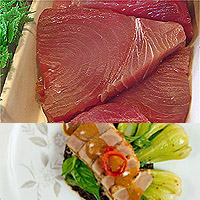Phosphatidylserine 20% Liquid (MCT) Non-Gmo
Tuna

Varieties
Albacore, found in both Atlantic and Pacific waters, is the only kind that can be labelled “white meat tuna.” Bluefin, a large, oily species, is usually tinned as “light meat” tuna or eaten raw. Yellowfin (called ahi in Hawaii) is the least oily kind of tuna; it is flavourful (but not strongly so) when cooked, and is good eaten raw. Bigeye is valued for sashimi. Bonito is among the smallest tuna, and has red meat. Tuna comes whole, in steaks, fillets, or loins, and fresh, frozen, or tinned.
Copyright © 2024 TraceGains, Inc. All rights reserved.
Learn more about TraceGains, the company.
The information presented in the Food Guide is for informational purposes only and was created by a team of US–registered dietitians and food experts. Consult your doctor, practitioner, and/or pharmacist for any health problem and before using any supplements, making dietary changes, or before making any changes in prescribed medications. Information expires December 2024.



 Come and see us at STAND D80 in our new position located on the lower floor between the main...
Come and see us at STAND D80 in our new position located on the lower floor between the main...  Today, consumers recognise that a healthy skin routine goes beyond using a good cream: keeping...
Today, consumers recognise that a healthy skin routine goes beyond using a good cream: keeping...  For over 20 years, sustainability, traceability, and transparency have driven Verdure Sciences®...
For over 20 years, sustainability, traceability, and transparency have driven Verdure Sciences®...  Our
Our  Despite concerns about the fish oil shortage over the past two years,
Despite concerns about the fish oil shortage over the past two years, 




































